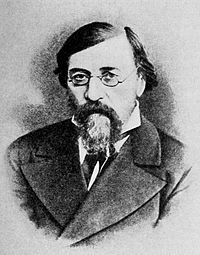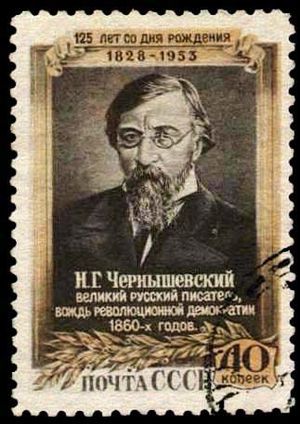Nikolay Chernyshevsky facts for kids
Quick facts for kids
Nikolay Chernyshevsky
|
|
|---|---|
 |
|
| Born | 24 July 1828 Saratov, Saratov Governorate, Russian Empire
|
| Died | 29 October 1889 (aged 61) |
| Nationality | Russian |
|
Notable work
|
What Is to Be Done? |
| Era | 19th-century philosophy |
| Region | Russian philosophy |
| School |
|
|
Main interests
|
|
|
Notable ideas
|
|
| Signature | |
Nikolay Gavrilovich Chernyshevsky (born July 24, 1828 – died October 29, 1889) was an important Russian writer, thinker, and journalist. He was known for his ideas about a perfect society (utopian socialism). He was also a leading figure in a movement called Russian nihilism.
Chernyshevsky was a key intellectual leader of a revolutionary movement in Russia during the 1860s. Even though he spent many years exiled in Siberia, his ideas were highly praised. Famous thinkers like Karl Marx and Vladimir Lenin admired his work.
Contents
Nikolay Chernyshevsky's Early Life and Education
Nikolay Chernyshevsky was born in Saratov, Russia, in 1828. His father was a priest. He lived in Saratov until 1846. He went to a local school called a seminary. There, he learned many languages, including English, French, German, and Latin. He also developed a great love for literature.
Later, he studied at Saint Petersburg State University. He sometimes struggled to keep his room warm. During this time, he became an atheist.
Chernyshevsky's Career and Beliefs
Chernyshevsky was inspired by the ideas of many philosophers. These included Ludwig Feuerbach and Charles Fourier. He was especially influenced by Vissarion Belinsky and Alexander Herzen. By the time he graduated from university in 1850, Chernyshevsky had strong beliefs. He believed in revolution, democracy, and materialism.
From 1851 to 1853, he taught Russian language and literature. He worked at the Saratov Gymnasium. He openly shared his ideas with his students. Some of them later became revolutionaries. From 1853 to 1862, he lived in Saint Petersburg. He became the main editor of a magazine called Sovremennik ("The Contemporary"). In this magazine, he published his main writings on literature and philosophy.
Chernyshevsky supported the revolutions that happened across Europe in 1848. He closely followed these events. He was happy when democratic and revolutionary groups made progress.
Chernyshevsky's Ideas on Art and Reality
In 1855, Chernyshevsky wrote a special paper called "The Aesthetic Relation of Art to Reality." This paper helped develop a new way of thinking about art in Russia. He believed that art should show what is important in real life. He thought art should be like a "textbook of life."
He wrote that science tries to understand reality to help people. He felt art should do the same. Art's goal, he said, is to show reality and explain it for the good of humanity.
Arrest, Exile, and Famous Novel
In 1862, Chernyshevsky was arrested. He was held in the Fortress of St. Peter and Paul. While imprisoned, he wrote his most famous novel, What Is to Be Done? This novel greatly inspired many Russian revolutionaries who came after him.
The book's hero, Rakhmetov, was completely dedicated to revolution. He lived a very strict life. He even slept on nails and ate only raw steak to become stronger for the revolution. Many people, including Vladimir Lenin, were inspired by this character. Lenin even wrote a political book with the same title.
In 1862, Chernyshevsky was sentenced to a "civil execution." This was a mock execution meant to scare him. After that, he was sent to forced labor from 1864 to 1872. Then, he was exiled to Vilyuisk, Siberia, from 1872 to 1883. He died at the age of 61.
Chernyshevsky's Influence on Society
Chernyshevsky helped start Narodism, which was a Russian populist movement. He pushed for a revolution to overthrow the government. He wanted to create a socialist society based on old peasant communities. He had a huge impact on young populists in the 1860s and 1870s.
Chernyshevsky thought American democracy was the best part of American life. He was happy when Abraham Lincoln was elected president in 1860. He believed this marked a new era for America. He said America would reach new heights, "not attained since Jefferson's time." He praised these changes, saying America's good reputation was important for all nations.
Chernyshevsky's ideas were strongly shaped by Alexander Herzen and Vissarion Belinsky. He saw class struggle as the way society moves forward. He supported the interests of working people. In his view, ordinary people were the main creators of history. He is known for using the phrase "the worse the better." This meant that if conditions for the poor got worse, they would be more likely to start a revolution.
Some experts, like Professor Joseph Frank, believe Chernyshevsky's novel What Is to Be Done? was very important. They say it created the strong feelings that led to the Russian Revolution. It was even more influential than Karl Marx's Das Kapital in this way.
The writer Fyodor Dostoyevsky was very upset by the simple ideas in Chernyshevsky's book. He wrote Notes from Underground partly as a response to it.
Vladimir Lenin, a Russian revolutionary and prime minister, praised Chernyshevsky. He said Chernyshevsky approached all political events with a revolutionary spirit. He was able to influence people by promoting the idea of a peasant revolution. He encouraged the masses to fight against old authorities, even with censorship.
Karl Marx and Friedrich Engels also studied Chernyshevsky's writings. They called him a "great Russian scholar and critic."
Some scholars also believe that Ayn Rand, who grew up in Russia, was influenced by Chernyshevsky's novel. The book was very popular and widespread during her childhood.
Chernyshevsky's Writings
- Aesthetic Relations of Art to Reality (1853)
- Essays on the Gogol Period in Russian Literature
- Critique of Philosophical Prejudices Against Communal Ownership
- The Anthropological Principle in Philosophy
- What Is to Be Done? (1863), a novel
- Prologue: A Novel for the Beginning of the 1860s (1870), a novel
- The Nature of Human Knowledge
See also
 In Spanish: Nikolái Chernishévski para niños
In Spanish: Nikolái Chernishévski para niños


